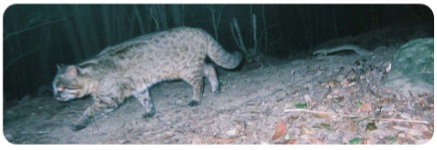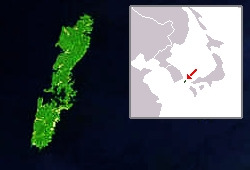Tsushima Cat
Posted by: Loren Coleman on March 8th, 2008


Guest blog from Japan by Brent Swancer:
In light of the recent blog on the Iriomote wildcat, I thought people might be interested to know that there is another type of wildcat living on Tsushima island in Japan, which lies on the western side of Kyuushu island, between Japan and Korea.
The endangered Tsushima wildcat is considered to be a subspecies of leopard cat and is thought to have arrived from the Asian continent around 100,000 years ago. Although the exact taxonomy of the cat is disputed, it is a different subspecies from the Iriomote wildcat.
The cat was designated as a national treasure in 1971 and declared an endangered species in 1994. Over the years, it’s population has dwindled due to land development and the building of roadways, with cars being one of the major killers of the cats. Current estimates put their numbers at fewer than one hundred individuals.
Interestingly, the cats live mostly in the Northern part of the island. They were thought to have been wiped out in the Southern part since 1984, when the last known specimen from there was found as road kill. None were seen in the Southern area until 2007, when a set of automated trail cams commissioned by the Environmental ministry caught one of the elusive cats on film there, which has given hope that perhaps they have either held on or are repopulating that area.
Tsushima island has a land area of 273.6 square miles and a population of just under 40,000 people.




For clarification, here is a specific subspecies breakdown:
There is a “new” subspecies of leopard cat, called the Tsushima cat, which lives in Tsushima, a small island between Japan and Korea. It is considered to be the same subspecies as the Manchurian cat, except just a little darker in coloration. They hide in the forests on the mountains of this small island, where they remain unpersecuted.
Prionailurus bengalensis bengalensis — India to Indo-China and Yunnan.
Prionailurus bengalensis borneoensis — Borneo leopard cat; has reddish hue to coat.
Prionailurus bengalensis chinensis — China and Taiwan
Prionailurus bengalensis euptailura — Far east, eastern Siberia, aslo known as the Amur Leopard cat
Prionailurus bengalensis horsfieldi — Kashmir to Sikkim
Prionailurus bengalensis manchurica — Manchurian leopard cat; lives in dense tropical forests.
Prionailurus bengalensis trevelyani — North Kashmir to South Baluchistan, Pakistan
Prionailurus bengalensis javaensis — Java and Bali; dull greyish coloration.
Prionailurus bengalensis minutus — Philippines
Prionailurus bengalensis sumatranus — Sumatran leopard cat; lower spot density.
About Loren Coleman
Loren Coleman is one of the world’s leading cryptozoologists, some say “the” leading living cryptozoologist. Certainly, he is acknowledged as the current living American researcher and writer who has most popularized cryptozoology in the late 20th and early 21st centuries.
Starting his fieldwork and investigations in 1960, after traveling and trekking extensively in pursuit of cryptozoological mysteries, Coleman began writing to share his experiences in 1969. An honorary member of Ivan T. Sanderson’s Society for the Investigation of the Unexplained in the 1970s, Coleman has been bestowed with similar honorary memberships of the North Idaho College Cryptozoology Club in 1983, and in subsequent years, that of the British Columbia Scientific Cryptozoology Club, CryptoSafari International, and other international organizations. He was also a Life Member and Benefactor of the International Society of Cryptozoology (now-defunct).
Loren Coleman’s daily blog, as a member of the Cryptomundo Team, served as an ongoing avenue of communication for the ever-growing body of cryptozoo news from 2005 through 2013. He returned as an infrequent contributor beginning Halloween week of 2015.
Coleman is the founder in 2003, and current director of the International Cryptozoology Museum in Portland, Maine.










I thought I read somewhere that the Borneo Leopard Cat was upgraded to species status. Anyone else hear that?
beautiful animal… one can almost picture a ‘squatch domesticating one as a pet! 😉
seriously, though, thanks for the update! i’ve learned more about existing animals once thought mythic or ‘folklore’ since participating in this forum than i have reading SCIENTIFIC AMERICAN for a dozen years!
keep up the good work, everyone! much appreciated here!
The taxonomy of both this cat and the Iriomote cat is disputed and constantly being evaluated. Some would say that the above list of subspecies of leopard cat should also include the Iriomote cat as Prionailurus bengalensis iriomotensis, while others disagree and say it is a separate species, a close relative of the leopard cat (basically a genetic variant within the same group), or even the sole member of its own genus.
The same kind of taxonomy difficulty can be seen with the Tsushima cat. Unlike the Iriomote cat (which is seen more by some to be a separate species) the Tsushima cat is definitely considered to be a subspecies of leopard cat, yet there is still dispute as to how to classify it. Some say the Tsushima cat is the same as the manchurian subspecies of leopard cat, but not everyone agrees. In fact, many sources you will see list this cat as Prionailurus bengalensis euptilura, saying that it is more or less the same as the Eastern Siberian Amur leopard cat. Still others list it as its own subspecies and label it Prionailurus bengalensis tsushimansis. Taxonomy can be a confusing thing and it is very much so with cats.
The only points that seem to be agreed upon with the classification of the Tsushima cat is that
1) It is different from the Iriomote cat
and
2) it is a subspecies of leopard cat.
I would say that based on the research I have read on the genetics of the Iriomote and Tsushima cats, they are two both sub-species of leopard cat as the two have been shown to share the same mitochondrial DNA lineage as the leopard cat (Felis bengalensis). Because they have been geographically isolated on their respective islands for so long, they have developed fixations of unique genetic and morphological characteristics due to adaptation and genetic drift. Essentially, they are very close to their original leopard cat stock, yet morphology and molecular phylogeny show them to show enough variation to be seperately classified as subspecies. Some have said in the past that the Iriomote cat was a seperate genus (Mayailurus) because it seemed to share characteristics with the leopard cat genus Prionailurus, yet also showed some affinity with the genera Pardofelis and Profelis. I’m sure there are those who would still argue that point.
Many think that the Tsushima cat is merely a variant of the Manchurian or Eastern subspecies of leopard cat, but I tend to think there could be enough there to make it a separate subspecies. It might seem like nitpicking or an unimportant distinction to some, but for the cats themselves, recognition as a species or sub-species can be very important as it can alter their conservation status.
Anyway, like I said, taxonomy can be tricky and the discussion is likely to continue.
This cat looks like my mother in law’s Bengal cat! It is beautiful, I love the tail.
There’s a good reason for the Tsushima Cat to resemble a domestic Bengal, since the development of the Bengal breed was initiated by crossing female domestic cats with male Leopard Cats. The hybrid kittens in subsequent generations were bred again with domestic cats and with other domestic/Leopard Cat hybrids, until the breed was stabilized as the beautiful Bengals that we see today.
Whether to consider the Iriomote Cats & Tsushima Cats to be island species in their own right, or subspecies one of the other, or either or both subspecies of the Leopard Cat, depends largely on which authority you consult. I personally think that the Iriomote Cat is distinct enough to be considered a separate (albeit closely related) species. From what I have seen and read of the Tsushima Cats, they appear to be an distinct island subspecies of Leopard Cat.
In recent years there has been a tendency among taxonomists to be “lumpers”, relegating a lot of animals formerly thought of as separate species to subspecies status and greatly reducing the number of generally accepted subspecies as well. I think that we are seeing some degree of reversal in this trend. Especially as the technology to decode DNA becomes ever more precise, I think that more cats will be recognized as distinct subspecies or even species.
Kittenz- That’s pretty much my take on it. The Tsushima cat is a subspecies of leopard cat and the Iriomote could very well be its own distinct species. Even experts do not all agree on the classification of these cats though, as I mentioned before. There is debate and discussion. Anyway, I’m a splitter myself. 🙂
LOL mystery_man, me too!
Great points MM and Kittenz…I’m a splitter when it’s sensible and a clumper when it’s not and what usually casts the die for me is what will express the highest level of protection and interest. Regardless of the criteria for what is or what isn’t a species from the molecular genetic point of view, they are definitely seperate species in the sense of their being seperate populations and no doubt genetic drift is more likely to keep them that way as if the significant amount of sea water wouldn’t. Thanks for the great information, as always. I’m hoping to see them myself some day.